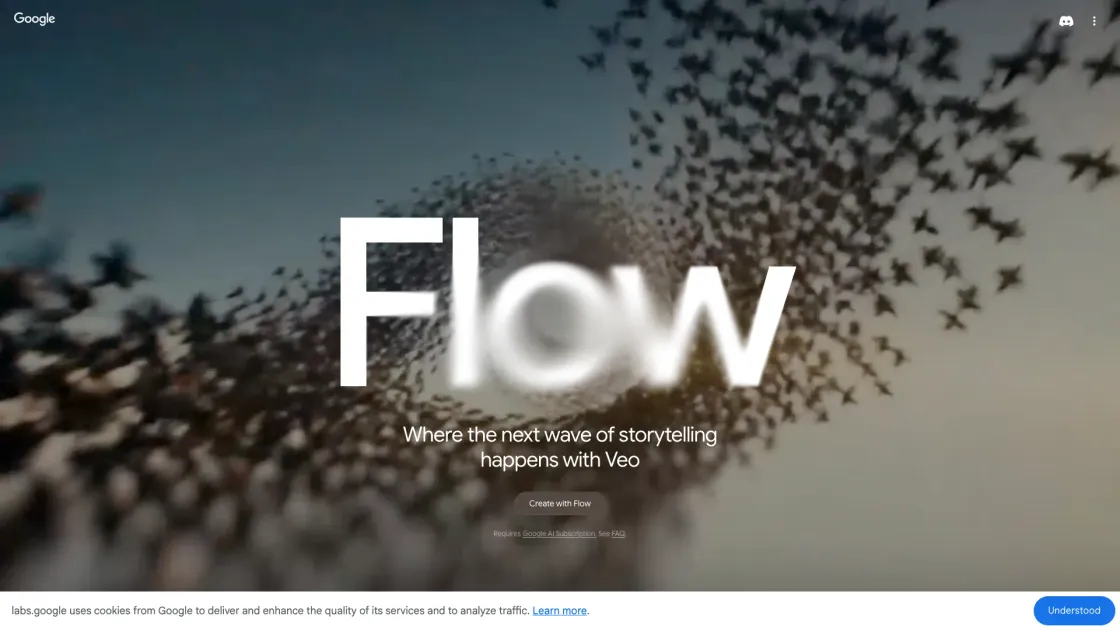Introduction to Google Flow
Google Flow is an AI filmmaking tool built with and for creatives, enabling users to seamlessly create cinematic clips, scenes, and stories using Google's most capable generative AI models. This platform is designed to assist storytellers in exploring their ideas without bounds, offering a suite of features that cater to both professionals and beginners in the filmmaking industry.
Key Features of Google Flow
Text-to-Video Generation
At the core of Flow is its ability to generate video content from textual prompts. By leveraging Google's Veo model, users can input detailed descriptions, and Flow will produce corresponding video clips. This feature allows for rapid prototyping of scenes and concepts, significantly reducing the time and resources traditionally required in the filmmaking process.
Camera Control
Flow provides direct control over camera movements, angles, and perspectives. Users can specify instructions such as "tracking shot" or "aerial view" to dictate how scenes are captured, offering a level of precision that enhances the storytelling experience.
Scene Builder
The Scene Builder feature allows users to edit and extend existing shots, facilitating seamless transitions and continuous motion between scenes. This tool is particularly useful for maintaining narrative flow and visual consistency throughout a project.
Asset Management
Flow includes an asset management system where users can organize and reference their generated or uploaded assets. This feature streamlines the creative process by keeping all elements easily accessible and manageable within the platform.
Audio Generation
With the integration of Veo 3, Flow offers native audio generation capabilities. Users can prompt the model to create ambient sounds, specific sound effects, or even generate dialogue, adding depth and realism to their video projects.
Pros and Cons of Google Flow
Pros
- Comprehensive AI Integration: Combines multiple AI models (Veo, Imagen, Gemini) to offer a robust filmmaking tool.
- User-Friendly Interface: Designed with creatives in mind, making it accessible for both professionals and beginners.
- Versatile Features: Offers a range of tools from text-to-video generation to camera control and audio integration.
- Efficient Workflow: Streamlines the filmmaking process, reducing time and resources needed for content creation.
Cons
- Subscription-Based Access: Requires a Google AI subscription, which may be a barrier for some users.
- Learning Curve: While user-friendly, mastering all features may take time for new users.
- AI Limitations: As with all AI-generated content, outputs may sometimes be inaccurate or require manual adjustments.
- Content Restrictions: AI outputs may be offensive or inaccurate, requiring careful review and editing.
Frequently Asked Questions
What subscription plans are available for Google Flow?
Google Flow is available through two subscription plans:
- Google AI Pro: Priced at $19.99 per month, offering features like Veo 3, text-to-video, frames to video, video extension, camera control, scene builder, and 1080p upscaling.
- Google AI Ultra: Priced at $249.99 per month, includes all Pro features plus Ingredients to Video, highest monthly generation limits, and additional benefits like YouTube Premium and increased storage.
Is Google Flow suitable for beginners?
Yes, Google Flow is designed to be user-friendly and accessible to both professionals and beginners in the filmmaking industry. Its intuitive interface and comprehensive features make it a valuable tool for anyone interested in AI-driven video creation.
Can I use my own assets in Google Flow?
Absolutely. Flow allows users to bring their own assets into the platform, enabling greater customization and personalization of video projects.
What are the limitations of AI-generated content in Flow?
While Flow leverages advanced AI models, users should be aware that AI-generated content may sometimes be inaccurate or require manual adjustments. Additionally, there may be content restrictions, and outputs should be reviewed to ensure they meet desired standards.
Conclusion
Google Flow represents a significant advancement in AI-driven filmmaking tools, offering a comprehensive suite of features that cater to the needs of modern storytellers. By integrating powerful AI models and providing user-friendly controls, Flow empowers creatives to bring their visions to life with unprecedented ease and efficiency.
